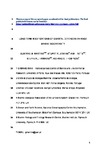Long-term modifications of coastal defences enhance marine biodiversity
| dc.contributor.author | Martins, GM | |
| dc.contributor.author | Jenkins, SR | |
| dc.contributor.author | Neto, AI | |
| dc.contributor.author | Hawkins, SJ | |
| dc.contributor.author | Thompson, Richard | |
| dc.date.accessioned | 2016-12-22T14:50:46Z | |
| dc.date.available | 2016-12-22T14:50:46Z | |
| dc.date.issued | 2016-06 | |
| dc.identifier.issn | 0376-8929 | |
| dc.identifier.issn | 1469-4387 | |
| dc.identifier.uri | http://hdl.handle.net/10026.1/8165 | |
| dc.description.abstract |
<jats:title>SUMMARY</jats:title><jats:p>Realization that hard coastal infrastructures support lower biodiversity than natural habitats has prompted a wealth of research seeking to identify design enhancements offering ecological benefits. Some studies showed that artificial structures could be modified to increase levels of diversity. Most studies, however, only considered the short-term ecological effects of such modifications, even though reliance on results from short-term studies may lead to serious misjudgements in conservation. In this study, a seven-year experiment examined how the addition of small pits to otherwise featureless seawalls may enhance the stocks of a highly-exploited limpet. Modified areas of the seawall supported enhanced stocks of limpets seven years after the addition of pits. Modified areas of the seawall also supported a community that differed in the abundance of littorinids, barnacles and macroalgae compared to the controls. Responses to different treatments (numbers and size of pits) were species-specific and, while some species responded directly to differences among treatments, others might have responded indirectly via changes in the distribution of competing species. This type of habitat enhancement can have positive long-lasting effects on the ecology of urban seascapes. Understanding of species interactions could be used to develop a rule-based approach to enhance biodiversity.</jats:p> | |
| dc.format.extent | 109-116 | |
| dc.language | en | |
| dc.language.iso | en | |
| dc.publisher | Cambridge University Press (CUP) | |
| dc.subject | Azores | |
| dc.subject | coastal urbanization | |
| dc.subject | community structure | |
| dc.subject | conservation | |
| dc.subject | habitat enhancement | |
| dc.subject | long-term | |
| dc.subject | Patella | |
| dc.title | Long-term modifications of coastal defences enhance marine biodiversity | |
| dc.type | journal-article | |
| dc.type | Journal Article | |
| plymouth.author-url | http://gateway.webofknowledge.com/gateway/Gateway.cgi?GWVersion=2&SrcApp=PARTNER_APP&SrcAuth=LinksAMR&KeyUT=WOS:000376036400002&DestLinkType=FullRecord&DestApp=ALL_WOS&UsrCustomerID=11bb513d99f797142bcfeffcc58ea008 | |
| plymouth.issue | 2 | |
| plymouth.volume | 43 | |
| plymouth.publication-status | Published | |
| plymouth.journal | ENVIRONMENTAL CONSERVATION | |
| dc.identifier.doi | 10.1017/S0376892915000284 | |
| plymouth.organisational-group | /Plymouth | |
| plymouth.organisational-group | /Plymouth/Faculty of Science and Engineering | |
| plymouth.organisational-group | /Plymouth/Faculty of Science and Engineering/School of Biological and Marine Sciences | |
| plymouth.organisational-group | /Plymouth/REF 2021 Researchers by UoA | |
| plymouth.organisational-group | /Plymouth/REF 2021 Researchers by UoA/UoA07 Earth Systems and Environmental Sciences | |
| plymouth.organisational-group | /Plymouth/Research Groups | |
| plymouth.organisational-group | /Plymouth/Research Groups/Marine Institute | |
| plymouth.organisational-group | /Plymouth/Users by role | |
| plymouth.organisational-group | /Plymouth/Users by role/Academics | |
| plymouth.organisational-group | /Plymouth/Users by role/Researchers in ResearchFish submission | |
| dcterms.dateAccepted | 2015-07-22 | |
| dc.identifier.eissn | 1469-4387 | |
| dc.rights.embargoperiod | Not known | |
| rioxxterms.versionofrecord | 10.1017/S0376892915000284 | |
| rioxxterms.licenseref.uri | http://www.rioxx.net/licenses/all-rights-reserved | |
| rioxxterms.licenseref.startdate | 2016-06 | |
| rioxxterms.type | Journal Article/Review |


